
 |
Recent Books by Forum Members |

 |
 |
|
|
|||||||
 |
|
|
Thread Tools | Display Modes |
|
#61
|
|||
|
|||
|
Brent, you asked a few questions about the antecedents of the Royal New Zealand Corps of Signals. I have finally found the box that contains the files for the Corps upto 1913. First G.O. 109 of 1909 states that College Rifle Volunteers (Auckland) disbanded and reform as a Cycle and Signalling Company with hq in Auckland with effect from 9 March 1909 gaz 25/09.
On another topic - crossed flags - G.O. 184 1909 states the following Third Class rating - certificate, badge (single flag) and personal payment 1 pound. Second class same but cross flags, first class badge gold and1 pound with extra 1 pound if proficient for three consecutive eyars. I HAVE NEVER SEEN THE SINGLE FLAG BADGE! New topic - Witht he withdrawal of Imperial Forces from NZ the NZ forces were obliged to take responsibility for establishing their own signalling and telegraphy. With diminished military obligations telegraphy and line duties were carried out by members of the New Zealand Armed Constabulary. With the reorganization of Volunteer Forces in 1882 a Report of Board of Officers Ordered to Assemble and Report Upon Every Branch of Present Volunteer System in New Zealand, stated that Engineers proposed that beyond No. 1 Coy of every infantry Regiment be composed of artisans. The necessity of special instruction applied also to a Torpedo and Signalling Corps. The Board considered engineer, torpedo, and signalling corps with a school of instruction for all branchs to be component pats of the scheme for defence set forth by Col Scratchely. In reality signalling became a component of the Torpedo Corps. New topic - When you think of signalling at the turn of the century you think either Engineers or Infantry signals. The truth is that there was a more to it than that. The return showing efficiency of the NZ forces for signalling in 1910 clearly show that Infantry and Mounted Infantry had a total of 58 qualified signallers (1st 2nd and 3rd class), the Engineers 92 and the Artillery 140. Interestingly there is mention of the College Rifles but it appears that there were no returns for that unit during that year. Rgds Quicksilver |
|
#62
|
|||||
|
|||||
|
Sorry for the slow reply, just been real busy of late.
Quote:
Given that Captain T H Dawson was appointed in 1909 as the Auckland District Signalling Staff Officer, and Lieutenant E. J. Hulbert (Post and Telegraph Rifles) was appointed as the Wellington District Signalling Staff Officer. (Lieutenant Hulbert was one of the two men most responsible for forming the Wellington Garrison Signallers Club in 1908) Do you know who the other 3 District Signalling Officers were? Quote:
Do you know if the British list a single flag from before or after 1908? Or is it unique to NZ? It seems to me that in 1909 certain NZ volunteer companies in each of the military districts were formed along the lines of “Divisional Communication Companies,” that were first introduced by the British Army Council in 1908. Quote:
Quote:
The 1882 Report by the Board of Officers was not actually acted upon until Major Cautley was appointed to the Senior Engineering position in 1884, and it wasn’t until 1885 that Lieutenant Douglas was appointed to the Permanent Staff and placed in control of the Torpedo Corps, that proper training was undertaken. Interestingly, Col Scratchely’s scheme for defence was dated the 1st March 1880. Basically it took years to reorganise the NZ coastal ports and implement his schemes, by 1887 over £170,000 had been spent putting Col Scratchely’s scheme into place, and in reality it was one of the first great economic blunders. The four torpedo boats and 20 torpedos alone cost over £20,000. Due to the fact that no capitation was earned for the Navals drilling with the torpedo boats, and no slips were purposely built for their launching, they were rearly used. The interesting part is that Seddon would make the same mistake and would also purchase some torpedo boats, only to find they were outdated by the time they arrived in NZ. When Seddon turned down Babbingtons 1904 requests he commented. — “Torpedo boats had been purchased for £2000 each, and one he had been able to dispose of at £100. Marinemining boats were purchased and found to be absolutely useless.” Taking this all on board, I do conceed that between 1883 and October 1884 when the Wellington Guards formed their Signalling Section, there is a possibility that one of the other military districts may have formed a Signalling Section. Until such evedence can be presented, the Wellington Guards would seem to be the first to have formed a Signalling Section. Quote:
Normally a set of new regulations would have been prepared in advance and issued with the change over, but due to Lord Kitchener's inspection tour they were put on hold. The period of March 1910 to March 1911 was basically a transition period, where many Volunteers did not continue on to become territorials. This would probably explain the low returns for qualified signallers during the 1910 period. I do know that Captain J E Duigan (Later on commanded the Tunneling Company) who at the time was an Engineer Officer on the General Instructional Staff, was sent to England in March 1910 for training, and on his return was supposed to take over training of both the Engineering and Signalling branches. It seems that Captain Duigan was reasigned due to his being specifically requested for service in India. Cliff, the rest is blank from 1911 to 1913, are you able to fill in the command structure of the Signal Corps between these dates? Cheers Brent |
|
#63
|
|||
|
|||
|
Brent,
To answer your previous questions as best I can: I am not aware of the names of the three other District Signalling Officers but I do have a few names of captains and below of both the NZ Signal Corps and the NZP&TC. As far as I am aware, the single flag trade badge was only worn in New Zealand. Perhaps others can tell us if this is not so. The NZ Vol companies after 1909 were based on Brigade signal companies rather than divisional signal companies. However, in 1914 when the NZ Signal Company went to Egypt it was a Div Signal Company along with the Mounted Bde Signal Troop. The Armed Constabulary assisted the Government Telegraph Department and provided linemen and operators in areas of unrest. Its good to know about the Wellington Guards forming their signal section which would have been semaphore. Engineers and Artillery would have used telegraphy and telephony at that time. Also I would expect other infantry units to have signalling or semaphore sections. Somewhere I have the OCs names of some of the NZ Signal Corps units but not handy. I do have a few of the officers names though in 1911 and the same for the NZP&TC including the Director. The attachment is a proposed unit badge for the Wellington Signals. It was not adopted. Regards Quicksilver |
|
#64
|
||||
|
||||
|
Cliff the Wellington Infantry Brigade Signal Company badge sketch is very interesting and I have not seen it before.
Any more information on it such as a date? It wouldn’t be any earlier than July 1911, so I’m thinking probably 1912 that it was projected. Major Harton (NZP&TC) was also in command of the Wellington Infantry Brigade Signal Company, so he would have had a say in its design or at least would have been responsible for its final approval before being sent to General Godley for acceptance. All very interesting indeed. |
|
#65
|
|||
|
|||
|
Brent,
There seems to have been a competion in 1912 for a suitable badge. Christchurch also submited a design but I have not found that in the archives just a letter about it. The variation on the college rifles badge won. Have the drawings for it and how they changed the scroll. Quicksilver |
|
#66
|
||||
|
||||
|
Quote:
Going by the photographic evedence the Auckland Divisional Signal Company (Formed from Auckland Cycle and Signal Company Division, which was in reality the College Rifles) did not seem to adopt the 1912 NZ Signal Corp badges, instead they seem to have retained the 1897 College Rifle badges. Here a couple of WW1 reinforcement photographs as examples. This picture is of Corporal Seymour Leighton Bent, Service No. 25050, 14th Reinforcements Divisional Signallers. Corporal Bent is wearing 1897 Auckland College Rifles collar badges and on the shoulder strap a 14 over a NZE shoulder title.  This picture is of Private Noel Johnston Campbell, Service No 33641, 22nd Reinforcements Specialist Company, Signal Section. Private Campbell is wearing a Type 1 Specialist Company cap badge and 1897 Auckland College Rifles collar badges. On the shoulder strap is a 22 over a NZSC (NZ Specialist Company) shoulder title. 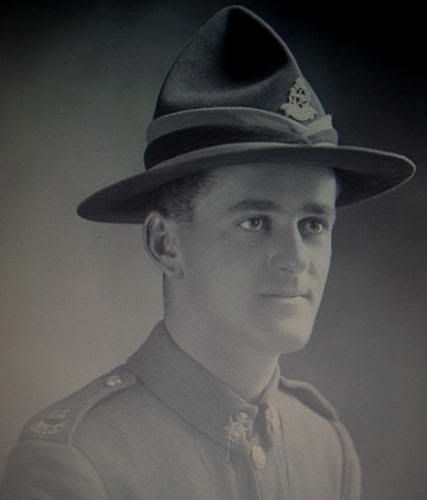 This picture is of Second Lieutenant Norman Russell Withiel Thomas, Service No 20940, 24th Reinforcements E Company. Lieutenant Thomas was a member of the Auckland Divisional Signal Company and had been with the College Rifles since 1909. Lieutenant Thomas is wearing a 24th Reinforcements officers version cap badge and 1897 Auckland College Rifles collar badges. 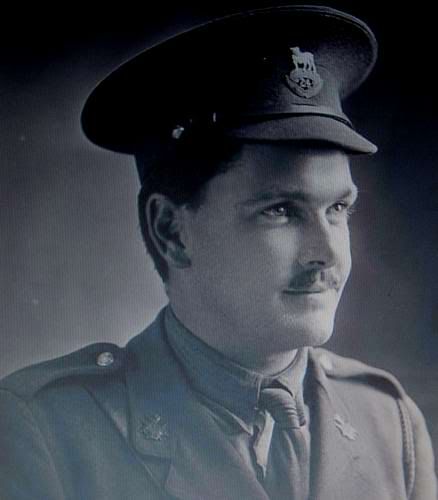
|
|
#67
|
|||
|
|||
|
The College Rifles badges were wasted out. I have a picture here taken in 1914 of Capt Dawson still wearing the College Rifles badge. Waste not want not. Badge wearing was a bit lax at times. Cyril Basset VC when asked why he was wearing an Australia rising sun type headdress badge in his slouch hat replied that he liked the look of it. Brent As I seem only to be able to get two scans on here I will email you some more documentation.
BRgds Quicksilver |
|
#68
|
||||
|
||||
|
Cliff, it’s finally all starting to make sense. I had wondered why I could not find any pre 1916 photos showing the Signal Corps badge being worn.
The document you have presented suggests the NZ Signal Corps badge was not actually produced until 1917.  This would explain the wearing of the 1897 College Rifles badges. |
|
#69
|
||||
|
||||
|
Quote:
Thanks to Cliff, we now know that General Godley (GOC) requested that a universal regimental badge be adopted for all Signal Corps in November 1911. Captain Dawson was requested by General Godley to communicate with all Signal Corps and submit a design for approval. Captain Dawson choice of design was submitted on the 20th February 1912,and was approved by General Godley on the 27th February 1912. I am assuming that the manufacturer of these badges was J R Gaunt. I am also assuming that the document dated the 17th May 1917 that is shown in Cliff’s last post relates to the point when Gaunt was dropped as a supplier and the badges were tendered to a New Zealand supplier.    
|
|
#70
|
|||
|
|||
|
I think you are on the right track. It is difficult trying to understand what happened 100 years or so ago but my guess is that the badge was approved and then Gaunt requested to make the badges. Perhaps it took some time for the order to be processed and samples to be sent to New Zealand and agreed to. My guess is that the bulk of the badges were left in Britain and then issued once the soldiers arrived at Sling Camp in England. That would explain the reinforcement badges and specialist badges in your photos. I note that the NZP&TC had their badges early on though.
Quicksilver |
|
#71
|
||||
|
||||
|
Quote:
It is worth considering that the NZP&T corps was an unattached unit, whereas each of the Divisional Signal Companies were attached directly to their parent battalions. As such, the Divisional Signal Companies were intitled to adopt the same badges as the battalion that they were attached to until regimental funds were available to purchase the proper corps badge. You are also 100% correct in that pre war stocks of NZ Regimental and Corps badges were generally exhausted suppling the NZEF Main Body, as such, due to the fact that the majority of NZ badges were manufactured in England at the time, it became standard procedure from the second reinforcements onwards to supply NZ Regimental and Corps badges in England rather than in New Zealand. The following hat badges kindly supplied by Tinto show the 1897 Auckland College Rifles and NZP&T Corps on the top row, and the large Mounted Signal troops and smaller Divisional Signal Corps badges on the bottom row. 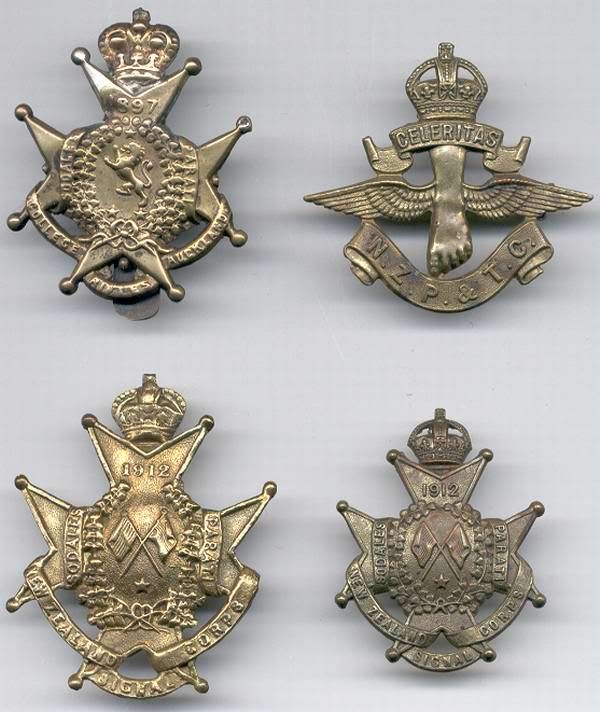 On the 1st July 1913 the NZ Post and Telegraph Corps, Mounted Signals troops and Divisional Signal Corps became part of the Engineers Signal Service, which entitiled these units to wear the flaming grenade collar badges and NZE shoulder titles. |
|
#72
|
||||
|
||||
|
What does “N.Z.S.C” stand for??????
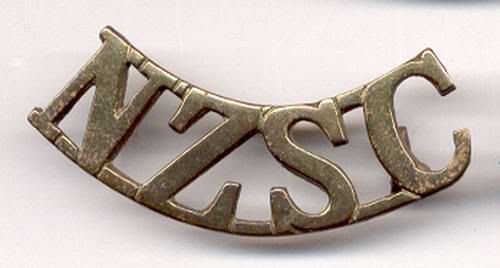 Having a quick check on page 79 (#12/85) of Geoff Oldham’s 1997 badge price guide, N.Z.S.C = New Zealand Signal Corps and also New Zealand Staff Corps. Although it is only speculation on my part, I would suggest that the New Zealand Staff Corps would not have adopted the “N.Z.S.C” shoulder title until after mid 1917 or IMO most likely in 1921 when the NZ Military forces were reorganised. What I can say for sure, is that the ‘1923 NZ Military forces Dress Regulations’ list the approved shoulder title for the New Zealand Staff Corps as ‘N.Z.S.C’ and the the approved shoulder title for the New Zealand Signal Corps as ‘N.Z.S.’ The following badges kindly supplied by Tinto show 3 variations of the N.Z.S.C shoulder title. The smaller N.Z.S.C title on the right is similar in size to several N.Z.P.S shoulder titles that I have seen, so I am inclined to think the small N.Z.S.C title was probably worn by the New Zealand Staff Corps.  The following picture shows Private William Henry Rowe, Service No. 40132, 24th Reinforcements (Second Draft) Specialist Company, Signal Section. Private Rowe is wearing third pattern Specialist Company collar badges and a N.Z.S.C shoulder title.  The following picture shows Lance Corporal Leslie Richard Dillicar, Service No. 71735, 38th Reinforcements C Company. Lance Corporal Dillicar is wearing third pattern Specialist Company collar badges, N.Z.S.C shoulder title and a Signallers arm badge. 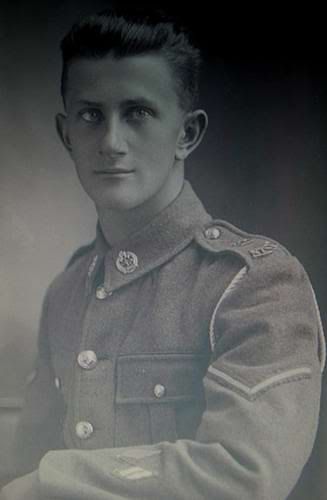 As with the N.Z.M.G.S shoulder badge, the NZ Defence Department did not officially supply the N.Z.S.C shoulder titles, so they would have been privately purchased by the reinforcements within the NZ training camps. While it seems logical according to Geoff Oldham’s catalogue that N.Z.S.C = New Zealand Signal Corps. I’m of the opinion that it more likely stands for ‘New Zealand Specialist Company.’ The following picture kindly supplied by Tinto show the various shoulder titles that were worn by the Post & Telegraph and Signallers within the reinforcement camps.  Invoice showing official shoulder titles supplied by the Defence Department (Unlike the one in my first post this one does not show the NZP&T shoulder title) 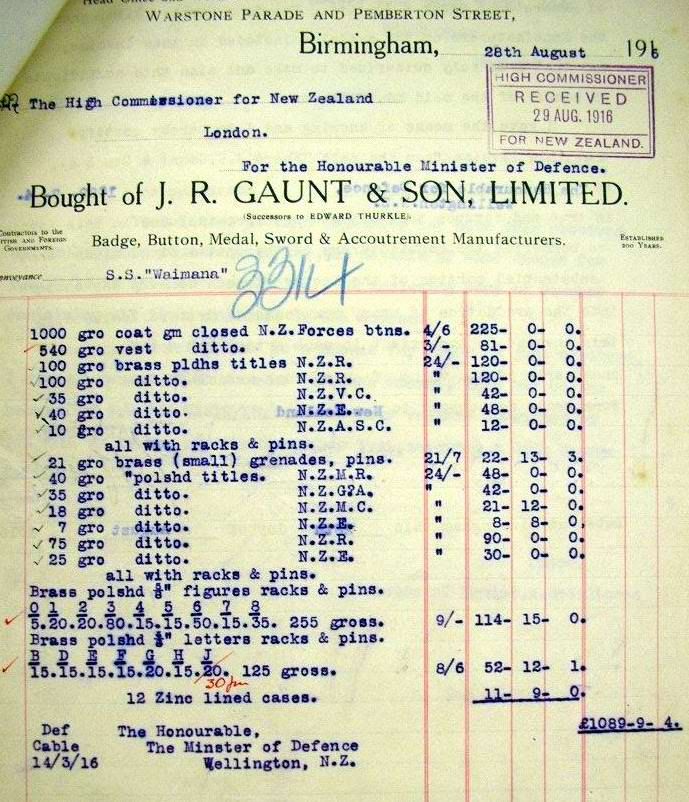
Last edited by atillathenunns; 12-06-11 at 11:11 AM. |
|
#73
|
|||
|
|||
|
The matter of NZCS is vexing. When Malcolm Thomas and I reserched our two books on NZ Army Distinguishing Patches 1911-1991 we did not find any information about a title NZSC before 1923. As Corps Historian for RNZ Sigs I have seen many pix in the Corps collection and have never seen the NZSC title. Cyril bassett did not wear NZCS and he was ex College Rifles and New Zealand Signal Corps. What we know is that when the NZP&TC and the NZ Signal Corps became part of the Engineers in 1913 that they wore the collar badges of the Engineers and the old NZ Signal Corps hat badge. (Think the NZP&TC continued to wear the NZP&TC collars). The title SIGNAL SERVICE as in my earlier photos of titles was worn and sometimes NZE. We know that the old College Rifles badges were wasted out. Perhaps the Wellington, and other companies had NZSC made up unofficially. One thing we know, the men going to England on the troopships wore whatever they fancied. In the pix I have here I have shown the collar badge of the College Rifles compared to the NZ Signal Corps collar badge. Brent did not show that. Also shown is the Mounted Signals headdress badge with Engineer collars. This is a reminder to collectors that they were worn like that and should have been from 1913 but the true date will probably never be known. Final comment, I discussed the NZSC many years ago with Dave Corbett, the person that Geoff Oldham got most of his information from. Dave got much information and badges from Dan Atkinson who had a massive collection of world wide badges and insignia. The largest I have ever seen. Massive. Dave Corbet was ex 5 Divisional Signals from WW2 before going into the RNZAF. He was adamant this was not a signals title but NZ Staff Corps. We now have photographic proof that it was worn by a few Specialists. Perhaps worn in error? It took this site to bring this to light. Great.
Quicksilver |
|
#74
|
||||
|
||||
|
Quote:
As mentioned these badges were unofficial, privately purchased and only worn in the New Zealand reinforcement camps and on the transport ships. I have so far found no photographic evidence of the Wireless troops or the Divisional Signallers within the reinforcement camps wearing N.Z.S.C shoulder titles, which is the reason that I highly doubt that N.Z.S.C stands for NZ Signal Corps. Although I would concede that N.Z.S.C could possibly stand for 'NZ Signal Company,' as this was occasionally used as an official title within the Specialist Company. However in saying all that, New Zealand Specialist Company makes more sense to me. Cliff, to be honest I am primarily a military headdress collector and only have a small collection of badges. So I am totally reliant and grateful to forum members such as yourself and Tinto for providing examples of the more rarer badges to support this thread. |
|
#75
|
|||
|
|||
|
In your last Brent you mention NZ Wireless - as far as I know, the only people who were wireless trained were the NZP&TC. The NZP&TC were of course the Post Office in uniform. They did however send a Troop to Mesopotamia and a section to Samoa. A NZ Pack Wireless Troop was very successful in Mesopotamia. See With Horse and Morse in Mesopotamia for more details. Photos I have from there show the NZP&TC badge was worn. Very little wireless work was done in Palestine from what I can see, if any. When the Mesopotamia Pack Wireless Troop was sent to France in 1918 I do not know what they did there. I think they were just reinforcements within the Divisional Signal Company and would have had the NZ Signal Corps badge. The purpose of the NZP&TC was to act from Div to Army whereas the NZ Signal Corps were at Brigade level and below to Div. To date I have found nothing to indicate that the Wireless Operators were employed as such in France. Some of them did go into Persia with Dunsterforce before being sent back to France though.
Quicksilver |
 |
|
|
 |